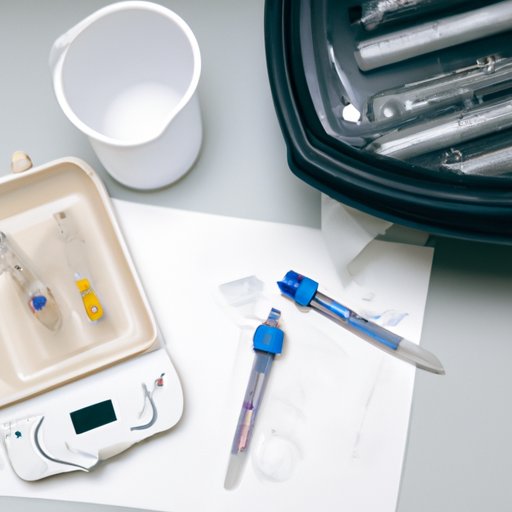Introduction
Gas chromatography (GC) is an analytical technique that is widely used in a variety of industries, including forensics. It is used to separate and analyze complex mixtures of chemicals, such as those found at crime scenes, in order to identify and quantify them. In this article, we will explore how gas chromatography is used in forensic science and the advantages it offers over other techniques.
Overview of Gas Chromatography
Gas chromatography is a separation technique that uses a mobile phase (typically a gas or vapor) to carry a sample through a stationary phase (typically a solid or liquid). This technique is based on the different interactions between the molecules of the sample and the stationary phase, which cause them to move at different speeds. As the sample moves through the stationary phase, it is separated into its components, which can then be identified and quantified.
Exploring the Role of Gas Chromatography in Forensic Science
In forensic science, gas chromatography is used to identify and quantify the presence of substances at a crime scene. These substances may include drugs, explosives, accelerants, poisons, and other chemicals. By analyzing the chemical composition of these substances, investigators can determine their origin and use in a crime.

Benefits of Using Gas Chromatography in Forensic Science
Gas chromatography offers several benefits when used in forensic science. First, it is highly sensitive and can detect trace amounts of a substance, allowing investigators to accurately quantify the amount present. Second, it is fast and can quickly provide results, making it ideal for use in time-sensitive cases. Finally, it can separate complex mixtures of chemicals, allowing investigators to identify and quantify multiple substances at once.

Examining the Use of Gas Chromatography in Crime Scene Investigations
Gas chromatography is often used in crime scene investigations to analyze substances found at the scene. For example, it can be used to identify and quantify the presence of drugs, explosives, and accelerants. It can also be used to detect trace amounts of substances that may have been used to commit a crime, such as poison or other toxins. By analyzing the chemical composition of these substances, investigators can gain valuable insight into the crime and the suspects involved.
Investigating How Gas Chromatography is Used in Forensic Analysis
Gas chromatography is also used in forensic laboratories to analyze evidence collected from a crime scene. For example, it can be used to analyze hair, blood, and other biological samples to determine their source. It can also be used to analyze clothing fibers, paint chips, and other materials to determine their origin and possible link to a crime.

Analyzing the Impact Gas Chromatography has on Forensic Evidence Gathering
Gas chromatography has had a significant impact on the way evidence is gathered in forensic science. With the help of this technique, investigators are able to analyze evidence more quickly and accurately than ever before. This allows them to uncover new leads, identify suspects, and build stronger cases against those responsible for a crime.
Investigating the Advantages of Gas Chromatography for Forensic Applications
There are a number of advantages that make gas chromatography an ideal choice for forensic applications. First, it is relatively inexpensive compared to other analytical techniques. Second, it is fast and can quickly provide results, making it ideal for use in time-sensitive cases. Finally, it can separate complex mixtures of chemicals, allowing investigators to identify and quantify multiple substances at once.

Comparing Gas Chromatography to Other Techniques Used in Forensic Science
Gas chromatography is not the only technique used in forensic science. Other common techniques include mass spectrometry, infrared spectroscopy, and ultraviolet-visible spectroscopy. Each of these techniques has its own advantages and disadvantages, and the choice of which one to use depends on the type of analysis being performed and the desired outcome.
“Each analytical technique has unique capabilities and limitations,” says Dr. Robert J. Kratz, a professor of forensic science at the University of New Haven. “It is important to understand the strengths and weaknesses of each technique in order to choose the most appropriate one for the task at hand.”
Conclusion
Gas chromatography plays a vital role in forensic science. It is highly sensitive, fast, and can separate complex mixtures of chemicals, allowing investigators to quickly and accurately identify and quantify substances found at a crime scene. It is also relatively inexpensive compared to other analytical techniques and can provide invaluable information that can help investigators uncover new leads and build stronger cases against those responsible for a crime.
(Note: Is this article not meeting your expectations? Do you have knowledge or insights to share? Unlock new opportunities and expand your reach by joining our authors team. Click Registration to join us and share your expertise with our readers.)
